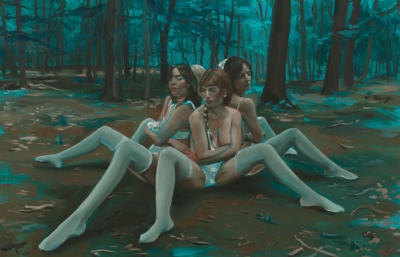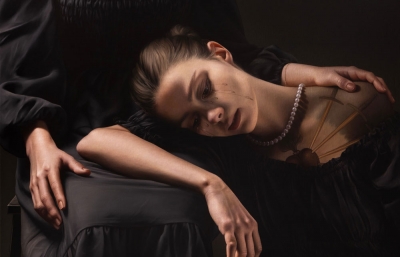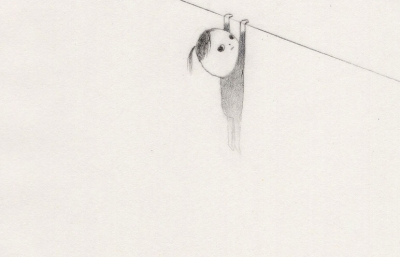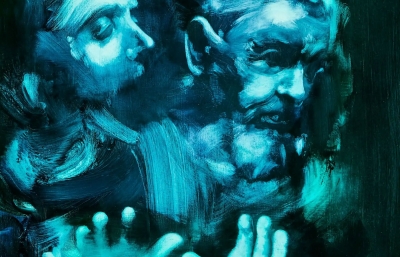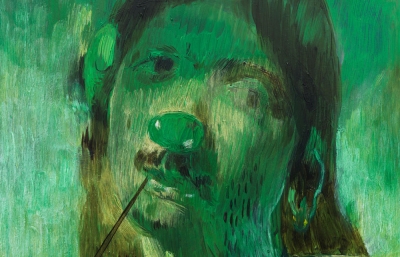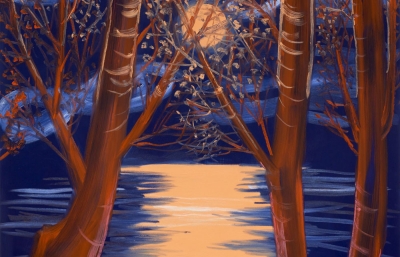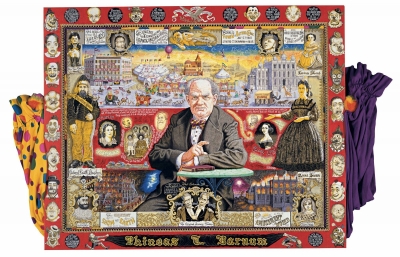Jake Troyli is bold. The colors, shapes, subject matter and scale is all that: bold. At first glance, there is something political and tangentially, very personal. For his latest show, Slow Clap, on view in Chicago at moniquemeloche, scale and color take centerstage, but also a unique storyline of absurdity and performance. As the gallery notes, Troyli "subverts narratives surrounding Black exceptionalism and exploitation, providing his own fresh perspective through humor, and positions the viewers as audience in order to ask important questions around performance for spectators versus performance for self, and who the payoff is actually for." Here is our conversation with the artist.
Evan Pricco: When do you begin working on this series? And what was on top of your mind when you started?
Jake Troyli: In this body of work I’ve been further exploring the idea of the subject, and what it means to be on display. And then, expanding on that, how easy it is for the line between subject and object to blurred. So in this series of paintings I wanted to play with that dynamic, stretching the figure into something less human and more object, like laundry hung out to dry over a line, a tree-like structure to be mounted and climbed, something to be hoisted up or pulled down.
What does the elongated body parts mean to you?
I think about the subjects in my work, usually my self-portraits, as elastic avatars, figures that can be stretched, distorted, and positioned, whether it be self-imposed (which I think of as a kind of metaphor for code-switching), or brought about by secondary forces or figures seeking to control or modify the subject/object to their liking. With this series of paintings I wanted to explore what that could mean in relationship to the body itself. So, like I mentioned before, the subjects bodies have been stretched, extended, and bent into new shapes in these compositions, all as a means to an end. But the question I think I’m asking myself and my viewer is this- once the stretching or the bending starts, where does it end?
Slow Clap and The Doorbuster Deal are absolutely beautiful works. I love how you treat an aerial scene. How are you prepping those as opposed to the portraits?
Thank you so much! those large-scale multi-figure works are really important to me, and I think of them as central in my practice, informing and breeding other works. The aerial perspective is also really important because like I mentioned before, I think so much about spectacle and being on display, so I want the viewer to have complete voyeuristic access to what’s going on in the paintings, sort of like looking into an ant colony. I build these works with very specific, sometimes absurd vignettes, separating them into compartments, really thinking about the relationship between the cells as integral to the complexity of the work. I want the works to be too much to take in all at once, and so they really encourage thoughtful viewership, as the person looking at the painting has to navigate their way through all the separate moments, seeing the piece as a network of smaller paintings all working in tandem as part of a larger ecosystem. Once I figure out the compositions of these large-scale pieces, I pull some of the vignettes out and rework them as midsize paintings, thinking of it as a micro-examination of a moment from the larger work that I felt required some more reflection.
Are you an optimist?
I actually hope that my work doesn’t provide a clear answer to this question. I want my audience to experience moments in my work that can feel like both sides of that binary without being too overtly in either camp. In terms of me personally, its an interesting question that I think could potentially over-inform the lens through which a viewer could access my work, so I’ll say that I like to think of myself, at least when it comes to art making, as a realist. One aspect of my practice that’s really important to me is criticality, but I want to maintain criticality even of systems I benefit from. And I like to think of that as a very realist approach.
How did you come to the title Slow Clap?
This goes back to being critical even of systems that benefit me. I played division 1 basketball in undergrad, and in hindsight I think that’s why I focus so much on the spectacle and being on display. It’s hard to deny that there can be an appeal in being on display, to being put on the pedestal in the position to be looked at or paid attention to, regardless of how bright that spotlight is or how dubious the intentions are of the audience. So along that line of thinking, I started to think a lot about reward systems, the affirmations the person on display(the spectacle) can receive. And so obviously I was considering applause, the clap, and what the slow clap could mean, the theater of the drawn out gesture as almost dangling the full satisfaction of the response over the head of the subject/object at the end of their performance.
Growing up and going to school in the South, what were some of the influences you had?
I didn’t grow up in a city with any kind of contemporary art presence, and so most of my early art exposure came through a relationship with comics and even more specifically, MAD magazine. My mom got me a subscription to it when I was young, and I was immediately obsessed. Now I see that was completely foundational in terms of building a visual language that is present in so much of my work today. I was also really attracted to the way these artists could use humor and palette to draw you into much broader sociopolitical conversations, important dialogue, in a way that felt very disarming and genuinely insightful. I hope my work can do the same.
Right now, what are you looking at that moves you?
Everything, really. First I’m constantly in awe of my peers in the art world, watching these incredible artists navigate their own language and viewpoints in ways that are increasingly brilliant, beautiful and inspiring. But I also try to load myself up with non art-related things to consume, shows(currently really sad this season of euphoria just ended), books(reading the handmaids tale right now), new hobbies(Im trying to learn how to play the guitar and have been getting pretty good at chess over the past two years)etc. I really think its important to take a break sometimes from just looking at “art” in the traditional, gallery sense and make sure we keep our intakes varied. A really brilliant artist I know said to me once “You can’t always be in the studio working because then you aren’t living, and if you’re not living, you won’t be able to make the work you need to be making” So i’m always chasing the thing that attracts me and inspires me, whatever that may be at the moment, and seeing where it can take me.
Slow Clap is on view through April 9, 2022.



















